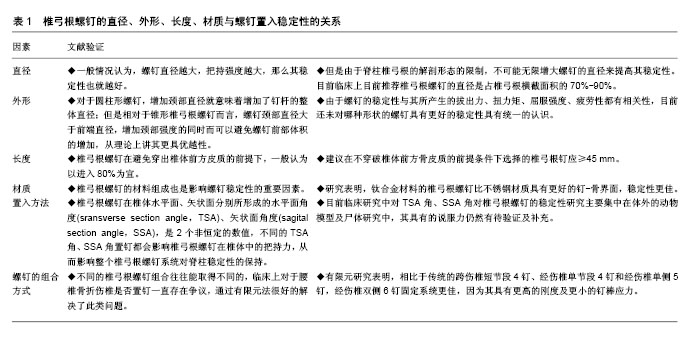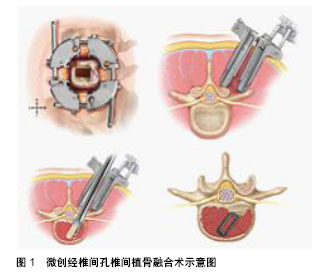| [1] Roy-camille R,Saillant G,Mazel C. Internal fixation of the lurmbar spine with pedical screw Plating.Clin Orthop. 1986;203:7-11.[2] Turner M,Martinh C. Stiffness and defilection analysis complex structure. Aero Sci. 1956;23(9):805-809.[3] Belytschko T,Kulak RF.Finite element stress analysis of an intervertebral disc.Biomech. 1974;7(3):277-285.[4] Goel VK,Kim YE,Lin TH,et al. An analytical investigation of the mechanics of spinal instrumentation. Spine. 1998;13(5):1003-1007.[5] 苏春涛, 眭承志.腰椎三维有限元生物力学分析的技术应用进展[J].中国康复医学杂志,2013,28(5):1001-1242.[6] Boucher HH.A method of spine fusion. J Bone Joint Surg.1959;41(5): 248-259.[7] Gaines RW,Carson WL. Experimental evaluation of Seven diferent spinal fraetare irdermal fixation devices using nonfailure stability testing.The wad-sharing and unstable-mecha-nism concepts. Spine. 1990;15:11-14.[8] Stefee AD, Biscuplt S, SitRowsid DJ. A new internal fixation device for disorders of the lumbar and thoraco-lumbar spine. Clin Orthop. 1986; 203:45-53.[9] Zhang QH, Tan SH, Chou SM. Effects of bone materials on the screw pull-out strength in human spine. Med Eng Phys. 2006;28(8):795-801.[10] 敖俊,方国芳,冯伟,等.以三维有限元模型分析短节段腰椎椎弓根螺钉系统固定后螺钉应力的分布[J].中国组织工程研究与临床康复, 2008,12(39): 7601-7604.[11] 王宇,靳安民,方国芳,等.腰椎椎弓根螺钉系统断裂的三维有限元分析[J].中国组织工程研究与临床康复,2008,12(48):9439-9442.[12] Chen CS,Chen WJ,Cheng CK,et al.Failure analys is of broken pedicle Screws on spinal Instrumentation.Med Eng Phys. 2005;27:487-496.[13] Hsu CC,Chao CK,Wang JL,et al.Increase of pullout strength of spinal pedicle screws with conical core:biomechanical tests and finite element analyses.J Oethop Res. 2005;23(4):78-94.[14] Chao CK, Hsu CC, Wang JL, et al. Increasing Bending Strength and Pullout Strength in Conical Pedicle Screws:Biomechanical Tests and Finite Element Analyses. J Spinal Disord Tech. 2008;21(2):130-138.[15] Weinstein JN,Rydevik BL,Rauschning W.Anatomic and technical considerations of pedicle screw fixation.Clin Orthop Relat Res.1992; (284):34-46.[16] 漆伟,雷伟,严亚波.椎弓根螺钉长度变化对螺钉-骨复合体模型应力影响的三维有限元分析研究[J].医用生物力学,2010,25(3):206-211.[17] Christensen FB,Dalstra M,Sejling F,et al.Titanium-alloy enhances bone-pedicle screw fixation: mechanical and histomorphometrical results of titanium-alloy versus stainless steel.Eur Spine J. 2000;9(2): 97-103.[18] Von Knoch M, Saxler G, Quint U.Titanium as an implant material for rods of transpedicular instrumentation of the lumbar spine. Biomed Tech (Berl).2004;49(5):132-136. [19] Soultanis K,Pyrovolou N,Karamitros A,et al.Instrumentation loosening and material of implants as predisposal factors for late postoperative infections in operated idiopathic scoliosis.Stud Health Technol Inform. 2006;123:559-564.[20] 段洪斌.不同水平角度置入椎弓根螺钉的拔钉生物力学研究[D].吉林大学, 2005.[21] 武启军.脊柱结核单节段椎弓根螺钉内固定的生物力学研究[D].宁夏医科大学,2010.[22] 覃涛,杜远立,郑东.计算机3D建模模拟个体化枢椎椎弓根钉最佳进钉方式的应用[J].中国矫形外科杂志,2014,22(19):1800-1804.[23] Magerl FP. Stabilization of the lower thoracic and lumbar spine with external skeletal fixation.Clin Orthop. 1984;(189):125-141.[24] Krag MH, Van Hal ME, Beynnon BD. Placement of transpedicular vertebral screws close to anterior vertebral cortex.Description of method. Spine. 1989;14(8):879-883.[25] Krag MH, Beynnon BD, Pope MH, et al. An internal fixator for posterior application to short segments of the thoracic,lumbar,or lumbosacral spine. Clin Orthop. 1986;(203):75-98.[26] Muller ME, Allgower M, Schneider R, et al. Manual of internal fixation techniques recommended by the AO ASIF group.3 ed, Springer verleg, Berlin Heidelberg,1991:666-670.[27] 王正,沈国平,陈伟兵,等. 椎弓根螺钉内固定稳定性的生物力学测试[J]. 医用生物力学,2002,17(2):80-84.[28] Sterba W, Kim DG, Fyhrie DP, et al. Biomechanical analysis of differing pedicle screw insertion angles. Clin Biomech. 2007;22(4):385-391.[29] Santoni BG,Hynes RA, Mcgilvray KC,et al.Cortical bone trajectory for lumbar pedicle screws.Spine J. 2009;9(5):366-373.[30] Lim TH, Eek JC, An HS, et al. Biomechanics of transfixation in pedicle screw instrumentation.Spine. 1996;21(19):2224-2229.[31] Lim TH, Kim JG, Fujiwara A, et al. Biomechanical evaluation of diagonal fixation in pediele screw instrumentation.Spine. 2001;26(22): 2498-2503.[32] Kuklo TR, Dmitriev AE, Cardoso MJ, et al. Biomechanical contribution of transverse connectors to segmental stability following long segment instrumentation with thoracic pedicle screws.Spine. 2008;33(15): 482-487.[33] Alizaden M, Kadir MR, Fadhli MM, et al. The use of X- shaped cross-link in posterior spinal constructs improves stability in thoracolumbar burst fracture: a finite element analysis. J Orthop Res. 2013;31: 1447-1454.[34] Li QL, Li XZ, Liu Y, et al. Treatment of thoracolumbar fracture with pedicle screws at injury level: a biomechanical study based on three-dimensional finite element analysis. Eur J Orthop Surg Traumatol. 2013;23:775-780.[35] Li C, Zhou Y, Wang H, et al. Treatment of unstable thoracolumbar fractures through short segment pedicle screw fixation techniques using pedicle fixation at the level of the fracture: A finite element analysis. PLoS One. 2014; 9:e99156.[36] 谭磊,李彦慧,于铁成,等.六钉系统中伤椎不同置钉方式治疗腰椎骨折的有限元分析[J].中华临床医师杂志:电子版,2015,9(19):3558-3562.[37] 张良.PLIF与TLIF对腰椎稳定性影响的有限元分析[D].吉林大学, 2016.[38] 余伟波,梁德,叶林强,等.TLIF 后路不同的内固定方式生物力学特性的比较分析[J].中国临床解剖杂志,2016,34(5):551-556.[39] Xu G, Fu X, Du C, et al. Biomechanical effects of vertebroplasty on thoracolumbar burst fracture with transpedicular fixation: a finite element model analysis. Orthop Traumatol Surg Res. 2014;10: 379-383.[40] Liu S, Qi W, Zhang Y, et al. Effect of bone material properties on effective region in screw- bone model: an experimental and finite element study. Biomed Eng Online. 2014;13:83.[41] Yan YB,Teo EC,Qiu TX,et al.Finite element study on the amount of injection cement during the pedicle screw augmentation.J Spinal Disord Tech. 2013;26:29-36.[42] 汪宇,潘滔,李佛保,等.椎板钩对椎弓根螺钉系统应力影响的有限元分析[J]. 中国临床解剖学杂志,2006,24(2):209-211.[43] 关海山,杨惠林,冯皓宇. 有限元分析肌肉力对胸腰椎运动节段椎间盘压力的影响[J].苏州大学学报(医学版),2007,27(2):209-213,221.[44] 刘雷,沈根标. 胸腰椎脊柱损伤的生物力学及有限元分析[J].实用骨科杂志,2001,7(5):354-357.[45] 张超,李宁宁.有限元法在脊柱内固定生物力学研究中的应用进展[J].临床医学工程,2011,18(10):1684-1698. |
.jpg)


.jpg)